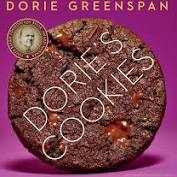
Bibliobites in November/December: Finding Dorie
 Who doesn’t love a cookie? They’re (mostly) neat to eat, they’re usually enjoyably petite, and they’re unintimidating to make. They’re a practical, popular, and yummy choice for parties and holiday dinners, and they’re eminently giftable. Prolific cookbook author and James Beard award-winner Dorie Greenspan’s Dorie’s Cookies tackles its eponymous topic with all the fervor and thoroughness you might expect from this baking maven. Did her collection of over 160 recipes hit the mark and help us attain cookie nirvana?
Who doesn’t love a cookie? They’re (mostly) neat to eat, they’re usually enjoyably petite, and they’re unintimidating to make. They’re a practical, popular, and yummy choice for parties and holiday dinners, and they’re eminently giftable. Prolific cookbook author and James Beard award-winner Dorie Greenspan’s Dorie’s Cookies tackles its eponymous topic with all the fervor and thoroughness you might expect from this baking maven. Did her collection of over 160 recipes hit the mark and help us attain cookie nirvana?
The size and heft of this book puts it squarely into coffee-table territory– literally, as it’s square rather than the more typical rectangle; so it easily stayed open– a quality much prized by group members! There are full-page photos of almost all the recipes; some people loved the closeup nature of the pictures (one cookie on a page– that’s a 9″ x 9″ cookie), but others thought the photos made the cookies look unnaturally shiny and plastic-y. The wider format of the pages made for a readable layout with ample white space; however, many of the headnotes were so long that a one-page recipe often overflowed into two or even three! Ingredients are listed by weight as well as volume, a plus for those of us who love our kitchen scales. Greenspan gives lots of ideas for changing up the recipes, and she lets you know which cookies freeze well, and the best way to do so; information much appreciated at a busy time of year. There were some complaints about baking times– for some of us, the indicated time almost always led to burned cookies, but others had the opposite experience! And knowing our own oven’s peculiarities didn’t always predict which issue we would have, so keep an eye on your cookies if it’s your first time with a particular recipe. But most importantly, how did the cookie crumble when it came time for baking and eating?
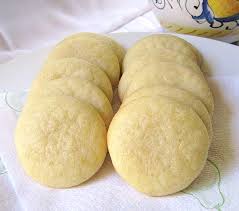 A couple of people tried the lemon sugar cookies, and both gave them high praise; though the dough was sticky and somewhat difficult to work with, the lemon flavor was strong and refreshing. The recipe has you rub sugar and lemon zest together with your fingers, which was effective in amping up that lemony tang. Almond crackle cookies were intriguing as they only have 3 ingredients (sugar, egg, and sliced almonds); they tasted good but fell apart and “went all over the place” when you tried to eat them. Perhaps these would be better crumbled over ice cream? Another recipe with a somewhat unusual list of ingredients was Natasha’s mum’s fruit and walnut bread bars. These had no fat in them at all; egg whites bind the fruit and nuts together. The result was a chewy, almost tough, bar that needed the recommended crystallized ginger to give it oomph; this recipe is an interesting idea but probably not a keeper. Also a bit different,
A couple of people tried the lemon sugar cookies, and both gave them high praise; though the dough was sticky and somewhat difficult to work with, the lemon flavor was strong and refreshing. The recipe has you rub sugar and lemon zest together with your fingers, which was effective in amping up that lemony tang. Almond crackle cookies were intriguing as they only have 3 ingredients (sugar, egg, and sliced almonds); they tasted good but fell apart and “went all over the place” when you tried to eat them. Perhaps these would be better crumbled over ice cream? Another recipe with a somewhat unusual list of ingredients was Natasha’s mum’s fruit and walnut bread bars. These had no fat in them at all; egg whites bind the fruit and nuts together. The result was a chewy, almost tough, bar that needed the recommended crystallized ginger to give it oomph; this recipe is an interesting idea but probably not a keeper. Also a bit different, 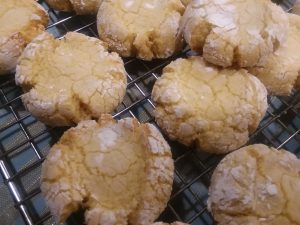 Moroccan semolina and almond cookies had a subtle citrus flavor and a slightly gritty texture from the semolina; a quality appealing to some, but a definite negative for others. Two bite one-chip cookies were a disappointment; they were “a pain to make” (you had to roll a small ball of dough, insert one chip into it, re-roll to hide the chip– 60 times!), and one person’s batch flattened out so much that the cookies looked a bit odd with their one little chocolate chip! Swedish dream cookies also flattened out too much and didn’t look much like their enticing photo, though the brown butter flavor was delicious. And crash-o cookies were a tasty version of oatmeal cookies (with raisins and chopped milk chocolate), but “they really needed nuts!”
Moroccan semolina and almond cookies had a subtle citrus flavor and a slightly gritty texture from the semolina; a quality appealing to some, but a definite negative for others. Two bite one-chip cookies were a disappointment; they were “a pain to make” (you had to roll a small ball of dough, insert one chip into it, re-roll to hide the chip– 60 times!), and one person’s batch flattened out so much that the cookies looked a bit odd with their one little chocolate chip! Swedish dream cookies also flattened out too much and didn’t look much like their enticing photo, though the brown butter flavor was delicious. And crash-o cookies were a tasty version of oatmeal cookies (with raisins and chopped milk chocolate), but “they really needed nuts!”
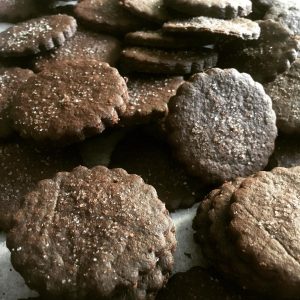 Melody cookies are based on the classic Nabisco cookie of the same name; these had good chocolate flavor but the dough was sticky and hard to roll out, and “Deb Perelman’s (of Smitten Kitchen) version is better.” However, world peace cookies were satisfyingly chocolaty and buttery. They were the slice-and-bake type, which made them easy and convenient to produce. Coffee malteds were also a hit; though the dough was sticky (is there a theme here?) the flavor combination was excellent and worth the trouble. Hamantaschen were also a bit fussy to make, but the end result was “really good.” The fruit filling in particular drew high praise. Matzoh morsels were a dried fruit and chocolate no-bake treat which were a creative (if expensive) way to use up matzohs; they were deemed “okay– but I wouldn’t bother making them again.” Leckerli was a Swiss honey-almond cookie similar to lebkuchen; these were fragrant with honey and orange, and were simple to put together. They did call for candied orange peel, for which Greenspan gives a recipe. I was intrigued by the idea of making it myself; and it was so easy to do, and the results so superior to store-bought that I may never buy it again!
Melody cookies are based on the classic Nabisco cookie of the same name; these had good chocolate flavor but the dough was sticky and hard to roll out, and “Deb Perelman’s (of Smitten Kitchen) version is better.” However, world peace cookies were satisfyingly chocolaty and buttery. They were the slice-and-bake type, which made them easy and convenient to produce. Coffee malteds were also a hit; though the dough was sticky (is there a theme here?) the flavor combination was excellent and worth the trouble. Hamantaschen were also a bit fussy to make, but the end result was “really good.” The fruit filling in particular drew high praise. Matzoh morsels were a dried fruit and chocolate no-bake treat which were a creative (if expensive) way to use up matzohs; they were deemed “okay– but I wouldn’t bother making them again.” Leckerli was a Swiss honey-almond cookie similar to lebkuchen; these were fragrant with honey and orange, and were simple to put together. They did call for candied orange peel, for which Greenspan gives a recipe. I was intrigued by the idea of making it myself; and it was so easy to do, and the results so superior to store-bought that I may never buy it again!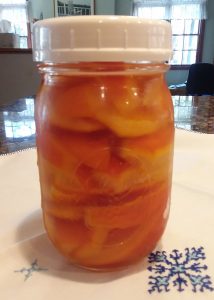
There’s a chapter towards the end of this book that’s called “cocktail cookies;” these are savory, (mostly) buttery bites that turned out to be the biggest hits in the book. Parmesan galettes were easy to make, and “I took them to a party and everyone loved them!” Continuing the cheesy/buttery theme, cheddar-seed wafers were enticingly cheesy and crispy, and they kept well. Rosemary-parm cookies had a somewhat off-putting color (from the pulverized fresh rosemary) but they tasted great, while sesame-sea salt cookies had a subtle yet addictive flavor that we enjoyed at our meeting! Goat cheese and chive cookies were a bit on the bland side; they’d benefit from a topper like the smoked salmon and cream cheese we also sampled at our meeting. And puffed grain and miso cookies were a fantastic, umami-laden version of rice cakes: sweet, salty, and craveable.
Overall, we enjoyed exploring this book: trying new versions of old favorites; branching out into different categories; or finding a new “keeper.” However, despite these positives, no one was rushing out to buy this book. Most of us already have plenty of cookie recipes that we love, not to mention cookie cookbooks; so we probably don’t need another tome for our already overstuffed shelves! And of course, many of the recipes in this (or any other) book are readily available online. If you’re new-ish to cookie-baking and want a book that pretty much covers it all, then this title could be really useful– to bake from and as a helpful reference. But for our group, the ratings once again told the tale: we averaged out to a 3.3 (out of a possible 5) rating. For us this book was likeable, just not a revelation– except for the cocktail cookies. Give ’em a try!
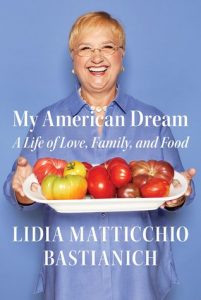 Our next meeting will be Friday January 25 at 11 AM in the Fireplace Room. This month, it’s a twofer: we’ll be reading Lidia Bastianich’s memoir My American dream: a life of love, family, and food; and cooking from Lidia’s Italy in America. Copies of both are available at the main desk. New members always welcome!
Our next meeting will be Friday January 25 at 11 AM in the Fireplace Room. This month, it’s a twofer: we’ll be reading Lidia Bastianich’s memoir My American dream: a life of love, family, and food; and cooking from Lidia’s Italy in America. Copies of both are available at the main desk. New members always welcome!
Happy New Year to all!






